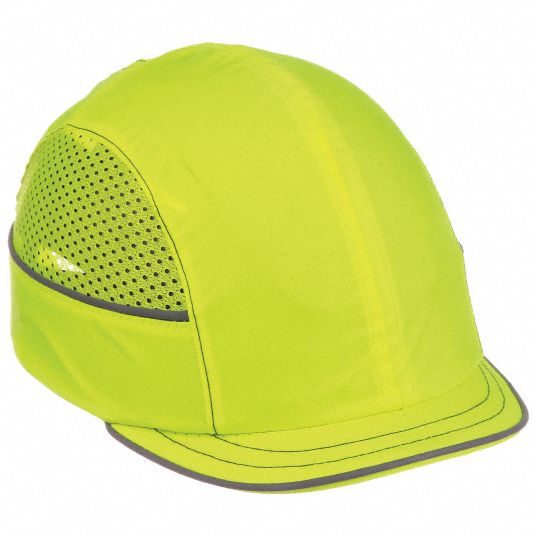Hard Hats: Types, Features, and OSHA’s Climbing Helmet Update
Understand full brim vs. standard cap vs. climbing helmets — and what OSHA’s latest update means for safer worksites.
Read more
Hard hats are essential in workplaces where head protection is crucial. They shield workers from falling objects, impacts, and electrical hazards. With various designs, materials, and features, it’s important to choose the right hard hat for your specific job requirements. Recently, OSHA issued new guidance emphasizing climbing helmets, adding another layer of consideration for worker safety.
Let’s explore the different types of hard hats, the distinctions between full brim, standard cap, and climbing helmets, and what the latest update means for workplace safety.
______________
Types of Hard Hats
1. Full Brim Hard Hats
- Description: These hard hats feature a brim that extends around the entire helmet, offering 360-degree protection.
-
Key Benefits:
- Shields the neck, ears, and face from sun, rain, and falling debris.
- Ideal for outdoor worksites with exposure to harsh weather conditions.
-
Common Industries:
- Construction
- Roadwork
- Utility work in open environments
-
Considerations:
- Heavier than standard cap designs.
- May feel bulkier, especially in tight spaces.
2. Standard Cap Hard Hats
- Description: The most commonly used style, featuring a shorter brim at the front, similar to a baseball cap.
-
Key Benefits:
- Lightweight and less obtrusive than full brim designs.
- Provides excellent overhead protection.
- Easy to integrate with accessories like face shields or earmuffs.
-
Common Industries:
- General construction
- Manufacturing
- Warehousing
-
Considerations:
- Limited side and back protection against weather and falling debris.
3. Climbing Helmets
- Description: Inspired by helmets used in recreational climbing, these helmets provide superior stability and side protection, making them a growing choice in industrial settings.
-
Key Features:
- 360-degree impact protection: Covers the sides, back, and top of the head.
- Chin straps: Secure the helmet in place during falls or sudden movements, preventing it from dislodging.
- Ventilation: Often include vents for airflow in hot environments.
- Lightweight and compact: Designed for long periods of wear.
-
Common Industries:
- Telecom and powerline work
- Tree care and arborist tasks
- Wind turbine maintenance
- Rope access and rescue operations
-
Considerations:
- Typically more expensive than traditional hard hats.
- May require additional training to ensure proper fit and use.
______________
Differences at a Glance
| Feature | Full Brim Hard Hats | Standard Cap Hard Hats | Climbing Helmets |
|---|---|---|---|
| Protection | Covers head, neck, and ears | Protects head; limited side coverage | 360-degree impact protection |
| Fit Stability | Basic suspension system | Basic suspension system | Chin straps for secure fit |
| Weight | Heavier | Lightweight | Lightweight |
| Applications | Outdoor, weather exposure | General use, indoor/outdoor | Elevated or fall-risk work |
| Price Range | Moderate | Affordable | Premium |
______________
OSHA’s New Climbing Helmet Update
In 2023, OSHA introduced updated guidelines recognizing the importance of climbing helmets for industries with elevated work and fall risks. While traditional hard hats are sufficient for many workplaces, they can fall short when workers are at risk of slipping or falling from heights.
Why the Change?
-
Traditional Hard Hat Limitations:
- Hard hats without chin straps can dislodge during falls or sudden movements.
- Limited side and back protection may not address all hazards in elevated work environments.
-
Climbing Helmet Advantages:
- Built-in chin straps keep helmets secure.
- Designed to meet ANSI/ISEA Z89.1 standards for workplace safety while incorporating EN12492 standards, emphasizing lateral impact protection and stability.
Industries Affected
Industries most impacted by this update include:
- Telecommunications: Workers climbing towers or poles need reliable head protection that stays secure.
- Tree Care and Logging: Arborists face risks of falling branches and slips.
- Renewable Energy: Wind turbine maintenance often requires helmets that stay in place during movement.
- Rescue and Rope Access: Teams navigating confined spaces or elevated rescues benefit from the enhanced protection of climbing helmets.
______________
Choosing the Right Helmet for Your Team
Selecting the appropriate helmet requires evaluating your workplace hazards, compliance requirements, and employee needs. Here are a few key tips:
- Assess the Environment: Determine the likelihood of falling objects, side impacts, and electrical hazards.
- Consider Stability Needs: For elevated work, prioritize climbing helmets with chin straps.
- Ensure Comfort: Lightweight materials and adjustable suspension systems can improve compliance.
- Check Standards: Make sure the helmet meets the necessary ANSI and OSHA standards for your industry.
Hard hats and climbing helmets are more than just compliance tools—they’re lifesavers. The introduction of OSHA’s climbing helmet guidance highlights the evolving nature of workplace safety and the need for better solutions in high-risk environments. Whether you’re outfitting your team with full brim hard hats for outdoor jobs, standard cap designs for everyday use, or climbing helmets for specialized work, the right choice can make all the difference.
At KwikSafety, we’re here to support your safety needs. Explore our collection of ANSI-rated hard hats and climbing helmets, and contact us for customization options like decal printing to promote your brand while staying safe!

























Leave a comment